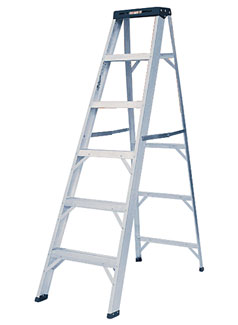Model:
Your Model No.:
Mfr. Model No.:

One ladder is rarely suitable for all jobs. The first "STEP" in ladder safety is selecting the correct ladder for the task at hand by answering the following questions:
Straight and extension ladders require support at both top and bottom. They are very versatile and available in a variety of sizes ranging from 16 to 60 feet in length.
Select the correct SIZE Extension Ladder for your needs.

Step ladders are designed to be self-supporting, and come in a variety of styles, and sizes ranging from 2 to 16 feet in length, and are in most cases designed to be used by one person at a time.
Trestle and 2-way step ladders can be climbed from either side, or support one person on each side.
Platform step ladders provide a large standing area which is more comfortable and safer to work from at fixed heights.
Choose the correct SIZE step ladder for your needs.

Combination ladders are very versatile, and can often be configured in several different positions, each best suited to a particular task. Most models can be used as a straight, 2-way step, scaffold, or stairway ladder. Their compact nature allows for easy storage and transport. They are available in several sizes and styles including telescopic, articulating and multi-way.

The following charts will allow you to determine the length of ladder you will require.

| Step Size | Max. Standing Ht. | Approx. Max. Work Ht.* |
| 4' | 1'11" | 8' |
| 5' | 2'10" | 9' |
| 6' | 3'9" | 10' |
| 7' | 4'9" | 11' |
| 8' | 5'8" | 12' |
| 10' | 7'7" | 14' |
| 12' | 9'6" | 16' |
| 14' | 11'5" | 18' |
| 16' | 13'4" | 20'** |
| Ext. Size | Max. Standing Ht. | Approx. Max. Work Ht.* |
| 16' | 12'6" | 9'6" |
| 20' | 16'6" | 13'6" |
| 24' | 20' | 17' |
| 28' | 24' | 21' |
| 32' | 28' | 24' |
| 36' | 31' | 28' |
| 40' | 33'6" | 30'6" |
| 44' | 37'6" | 34'6" |
| 48' | 41' | 38'6" |
| 60'*** | 46'6" | 43'6" |
*Assumes 5'6" person with 6'6" reach
**Consider scaffolding
*** Three section ladder
The feet of a straight or extension ladder should be set at a point one foot horizontally outward from the upper support, for every four feet of vertical distance between the ladder feet and the upper support point.


Each Featherlite extension, straight, and combination ladder is equipped with a label similar to this, to assist in set-up. With the ladder set up correctly (approx. 76° from horizontal), the long leg of the “L” will appear vertical.
Ladders are made from a number of materials, each having its own characteristics.
The most common material of construction.

An “engineered” material consisting of continuous strands of high-strength glass fibres and mats encapsulated in a resin matrix.

A natural material, most popular prior to introduction of aluminum and fibreglass ladders.


When selecting a duty rating adequate for your needs, you MUST allow for the combined weights of: The user + clothes + tools + material.
The maximum load rating of the selected ladder should NEVER be exceeded.
Duty Rating Chart
| Max. Load Capacity | Rated Use | CSA | ANSI |
| 200 lbs. | Light-Duty Household Designed for infrequent household chores, cleaning, painting, etc. |
Grade 3 | Type III |
| 225 lbs. | Medium-Duty Commercial Designed for moderate use by homeowners, painters, handymen, etc. |
Grade 2 | Type II |
| 250 lbs. | Heavy-Duty Industrial Designed for use by contractors in maintenance, construction and industrial applications |
Grade 1 | Type I |
| 300 lbs. | Extra Heavy-Duty Designed for frequent use in maintenance, construction and industrial applications |
Grade 1 | Type 1A |
| 375 lbs. | Special Heavy-Duty Designed for the most demanding industrial and construction applications |
Grade 1 | Type 1AA |
While CSA recognizes neither the Type 1A or 1AA duty ratings, many products have been designed and tested to meet or exceed the higher ANSI Type 1A and 1AA load ratings commonly specified by industrial and trades users, in addition to retaining CSA Grade 1 certification.
Max quantity is 999999999. Your cart item has been updated
Model:
Your Model No.:
Mfr. Model No.:
Qty.: